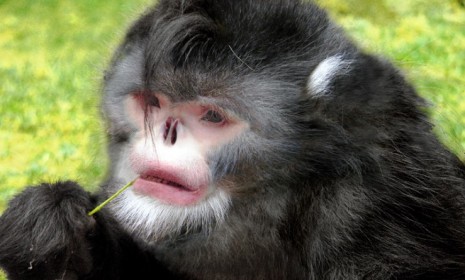The 10 weirdest new species of 2012
A mushroom named after SpongeBob, a sneezing monkey, and a blue tarantula top this year's list of Earth's most bizarre residents

It's estimated that Earth is home to at least 8 million living species, and every year scientists add 15,000 to 20,000 new discoveries to that tally. But thousands of species are threatened with extinction, too, thanks to habitat destruction, climate change, and other factors. For the past five years, in an effort to bring attention to the biodiversity crisis, the International Institute for Species Exploration (IISE) at Arizona State University has worked in conjunction with biologists worldwide to cobble together the newly added animals and plants they find most interesting. More than 200 organisms were nominated, but only a few were selected. In no particular order, here are this year's 10 strangest additions to the world's living things:
1. The SpongeBob SquarePants mushroom
The Malaysian mushroom that "lives in the rain forest, under a tree" is nearly as strange as its Nickelodeon namesake, says Wynne Parry at LiveScience. The resilient fungus, known scientifically as Spongiforma squarepantsii, can be squeezed and wrung, but still returns to its original form.
The Week
Escape your echo chamber. Get the facts behind the news, plus analysis from multiple perspectives.

Sign up for The Week's Free Newsletters
From our morning news briefing to a weekly Good News Newsletter, get the best of The Week delivered directly to your inbox.
From our morning news briefing to a weekly Good News Newsletter, get the best of The Week delivered directly to your inbox.
Photo: Thomas Bruns
2. A monkey that sneezes when it rains
This strange-looking monkey has black fur and a white beard, with a stubby, upturned nose that causes it to sneeze whenever it's raining. "To avoid inhaling water, the monkeys supposedly sit with their heads tucked between their knees on drizzly days," says LiveScience's Parry.
Photo:
A free daily email with the biggest news stories of the day – and the best features from TheWeek.com
Thomas Geissmann/Fauna & Flora International
3. A walking cactus
At first glance, the newly discovered but long-extinct organism looks like a small, two-inch cactus. But Diania cactiformis is actually a worm-like arthropod with a hard exoskeleton and multiple legs, and may even be an ancient ancestor of modern spiders and crustaceans.
Photo: Jianni Liu
4. The Devil's worm
These tiny 0.02-inch long worms were discovered nearly a mile inside a South African gold mine — the deepest a multi-cellular organism has ever been found, says Thomas H. Maugh II at the Los Angeles Times. "It was named Halicephalobus mephisto from the Faust legend because it survives at high pressures and temperatures."
Photo: A.G. Borgonie, Ghent University, Belgium; Scanning electron microscope (SEM) image, face view of H. mephisto
5. An orchid that only blooms at night
In Papua New Guinea, a rare orchid named Bulbophyllum nocturnum opens up around 10 p.m. and closes early the next morning. As far as experts know, it's the only nocturnally blooming orchid.
Photo: Andre Schuiteman
6. A parasitic, egg-laying wasp
This tiny Spanish parasite, Kollosmosoma sentum, is constantly on the prowl for ants. In a blink-of-the-eye sting that lasts just 1/20th of a second, the wasp is actually laying eggs into the ants' abdomen. (Watch a video here.)
Photo: C. van Achterberg
7. A blue tarantula
What's furry, has eight legs, and is blue all over? This "breathtakingly beautiful" iridescent tarantula from Brazil — the first creature from the country to ever make the list.
Photo: Rogério Bertani/ Instituto Butantan
8. A high-altitude poppy
The rare flower named Meconopsis autumnalis looks like an ordinary yellow poppy. So what makes it special? The flower only grows in the thin-aired mountains of Nepal, well over 10,000 feet above sea level.
Photo: Paul Egan
9. A meaty millipede
The Crurifarcimen vaganas from Tanzania is 6.3 inches long and boasts 56 pairs of legs, making it the world's largest millipede. Researchers have dubbed it the "wandering leg sausage" thanks to its uncanny resemblance to the tubular meat product.
Photo: Brovad
10. A kite-like jellyfish
This "strikingly beautiful but venomous box jelly" was first sighted in 2001, but has become increasingly prevalent around the globe. Over 300 entries were submitted in an online competition to name the translucent species before the name Tamoya ohboya was officially selected. Presumably, the name was inspired by the yelps ("Oh boy!") uttered by victims of the jellyfish's sting.
Photo: Ned Deloach
-
 5 loony toons about the Warner Bros. buyout
5 loony toons about the Warner Bros. buyoutCartoons Artists take on movie theaters, high quality cinema, and more
-
 Political cartoons for December 13
Political cartoons for December 13Cartoons Saturday's political cartoons include saving healthcare, the affordability crisis, and more
-
 Farage’s £9m windfall: will it smooth his path to power?
Farage’s £9m windfall: will it smooth his path to power?In Depth The record donation has come amidst rumours of collaboration with the Conservatives and allegations of racism in Farage's school days
